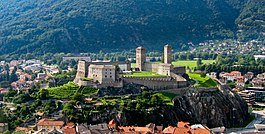Bellinzona
| Bellinzona | ||
|---|---|---|

Castelgrande Bellinzona in late-August 2004
|
||
|
||
| Coordinates: 46°12′N 9°01′E / 46.200°N 9.017°ECoordinates: 46°12′N 9°01′E / 46.200°N 9.017°E | ||
| Country | Switzerland | |
| Canton | Ticino | |
| District | Bellinzona | |
| Government | ||
| • Executive |
Municipio with 7 members |
|
| • Mayor |
Sindaco (list) Mario Branda (as of February 2014) |
|
| • Parliament |
Consiglio comunale with 50 members |
|
| Area | ||
| • Total | 19.15 km2 (7.39 sq mi) | |
| Elevation | 238 m (781 ft) | |
| Population (Dec 2015) | ||
| • Total | 18,308 | |
| • Density | 960/km2 (2,500/sq mi) | |
| Postal code | 6500 | |
| SFOS number | 5002 | |
| Localities | Artore, Carasso, Daro, Ravecchia | |
| Surrounded by | Arbedo-Castione, Giubiasco, Gorduno, Monte Carasso, Pianezzo, Sant'Antonio | |
| Website |
www SFSO statistics |
|
Bellinzona (Italian pronunciation: [bellinˈtsoːna];French: Bellinzone [bɛlɛ̃zon], German: Bellenz [ˈbɛlɛnts], Romansh: Blizuna [bliˈtsuːnə]) is the capital of the canton Ticino in Switzerland. The city is famous for its three castles (Castelgrande, Montebello, Sasso Corbaro) that have been UNESCO World Heritage Sites since 2000.
The town lies east of the Ticino river, at the foot of the Alps. It stretches along the river valley, surrounded by the southern ranges of the Lepontine Alps to the east and west, and by the Lugano Prealps to the south.
The toponym is first attested in 590 in Latin as Belitio or Bilitio (in the accusative, Bilitionem), by Gregory of Tours. The name is Lepontic in origin, possibly from belitio ("juniper") or belitione ("juniper bushes").
During the medieval period, the name is found as Berinzona (721, 762, 803, 1002), Birrinzona (1004), Birizona (1168), Beliciona (901, 977) and Belinzona (1055). The German name of the town is Bellenz. A local folk etymology derives the name Bellinzona from zona bellica "war zone", making a connection to the Italian Wars.
...
Wikipedia



